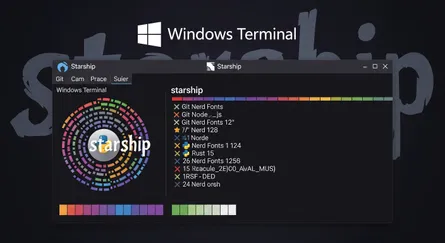Introduction
Git connects to remotes by default via HTTPS, which requires you to enter your login and password every time you run a command like Git pull or git push, using the SSH protocol. You may connect to servers and authenticate to access their services. The three services listed allow Git to connect through SSH rather than HTTPS. Using public-key encryption eliminates the need to type a login and password for each Git command.
Make sure a Git and SSH client is installed
A Git and SSH client must be installed on your system to connect via the SSH protocol. It should be installed by default if you use Arch Linux-based distributions like Manjaro or Garuda Linux.
git --versionssh -VThat command should return the Git version adn SSH client’s version number:
git version 2.34.1OpenSSH_8.8p1, OpenSSL 1.1.1l 24 Aug 2021If the system tells you that the ssh or git commands are missing, use the following command to install them:
Arch-based Linux systems:
sudo pacman -Syusudo pacman -Syyusudo pacman -S gitsudo pacman -S opensshDebian-based Linux systems:
sudo apt updatesudo apt upgradesudo apt install gitsudo apt install opensshRed Hat-based Linux systems:
sudo yum upgradesudo yum install gitsudo yum install opensshSuse-based Linux systems:
sudo zypper upgradesudo zypper install gitsudo zypper install opensshFedora-based Linux systems:
sudo dnf upgradesudo dnf install gitsudo dnf install opensshDon’t forget to specify global Git settings using the following command after installing git:
git config --global user.name 'USERNAME'git config --global user.email 'YOUR_EMAIL@EXAMPLE.COM'Look for any SSH keys that have already been created
ls -lah ~/.sshThe contents of the ~/.ssh folder, where the SSH client stores its configuration files, should be listed by that command:
Don’t worry if you get an error saying there is no \.ssh directory or no files in there: it just indicates you haven’t established an SSH key pair yet. Proceed to the next subject if this is the case.
It is advised that you produce a fresh SSH key pair at least once a year for security reasons. It is advised that you go on to the following topic if you already have an SSH key pair that was established more than a year ago. You can skip the following subject if you already have an SSH key pair and wish to reuse it.
Make a fresh set of SSH keys
Run the following command (change your YOUR_EMAIL@EXAMPLE.COM with your email address) to establish a new SSH key pair:
ssh-keygen -t rsa -b 4096 -C 'YOUR_EMAIL@EXAMPLE.COM'It will ask you where you want to save the private key (id rsa), and you may accept the default location by pressing Enter.
Generating public/private rsa key pair. Enter file in which to save the key (/home/your_user_name/.ssh/id_rsa):Whether you already have a private key, it will ask if you want to override it:
/home/your_user_name/.ssh/id_rsa already exists.Overwrite (y/n)?If this happens, hit Enter and type y. Then, enter and re-enter the following passcode (think of it as a password):
Enter passphrase (empty for no passphrase):Enter same passphrase again:The SSH key pair is created in ~/.ssh, and the whole interaction should look like this:
your_user_name@your_host_name:~> ssh-keygen -t rsa -b 4096 -C 'YOUR_EMAIL@EXAMPLE.COM'Generating public/private rsa key pair.Enter file in which to save the key (/home/YOUR_USER_NAME/.ssh/id_rsa):/home/YOUR_USER_NAME/.ssh/id_rsa already exists.Overwrite (y/n)? yEnter passphrase (empty for no passphrase):Enter same passphrase again:Your identification has been saved in /home/YOUR_USER_NAME/.ssh/id_rsa.Your public key has been saved in /home/YOUR_USER_NAME/.ssh/id_rsa.pub.The key fingerprint is:SHA256:XenY8FOQmvIsjKVp6oAlITe3k1aMKRdViOFePP6/CuK YOUR_EMAIL@EXAMPLE.COMThe key's randomart image is:+---[RSA 4096]----+|o.=@X++. ||o*@O++ ||=Bo+=+ ||Oo+ oo.. ||=+ . .. S ||... o || . o . || . . o || E . o. |+----[SHA256]-----+YOUR_USER_NAME@YOUR_HOST_NAME:~>To the ssh-agent, add your private SSH key
If you don’t want to input your password every time you use your SSH keys, add it to the ssh-agent, which is a background application that saves your keys in memory while you’re signed in to the system.
Run the following commands to start the ssh-agent in the background:
eval "$(ssh-agent -s)"The ssh-agent process identification is returned by this command:
Agent pid 2887Then, in the ssh-agent, add your SSH private key:
ssh-add ~/.ssh/id_rsaPress Enter once you’ve typed your password:
Enter passphrase for /home/YOUR_USER_NAME/.ssh/id_rsa:The ssh-agent has been updated with the private SSH key, according to this command:
Identity added: /home/YOUR_USER_NAME/.ssh/id_rsa (YOUR_EMAIL@EXAMPLE.COM)To your account, add the public SSH key
You can connect through SSH after you have an SSH key and have added it to the ssh-agent. Let’s take a look at how to implement it with each of the three servers: GitHub, GitLab, and Bitbucket.
The procedure is the same in all three circumstances, xclip is a command-line tool that gives you access to the clipboard in the graphical user interface from the terminal. If it isn’t already installed, perform the following commands to do so:
Arch-based Linux systems:
sudo pacman -Syusudo pacman -Syyusudo pacman -S xclipDebian-based Linux systems:
sudo apt updatesudo apt upgradesudo apt install xclipRed Hat-based Linux systems:
sudo yum upgradesudo yum install xclipSuse-based Linux systems:
sudo zypper upgradesudo zypper install xclipFedora-based Linux systems:
sudo dnf upgradesudo dnf install xclipUsing the xclip command, copy the contents of your public SSH key (/.ssh/id rsa.pub) file to the clipboard:
xclip -sel clip < ~/.ssh/id_rsa.pubGitHub
Sign in to your GitHub account using a browser by going to github.com and entering your username and password. Click your profile photo in the upper-right corner of the page, then Settings:

Select SSH and GPG keys from the user settings sidebar. Then select New SSH key from the drop-down menu. Put a descriptive label for the new key in the Title area (for example, your computer’s name) and paste your public key into the Key field. Last but not least, click Add SSH key:
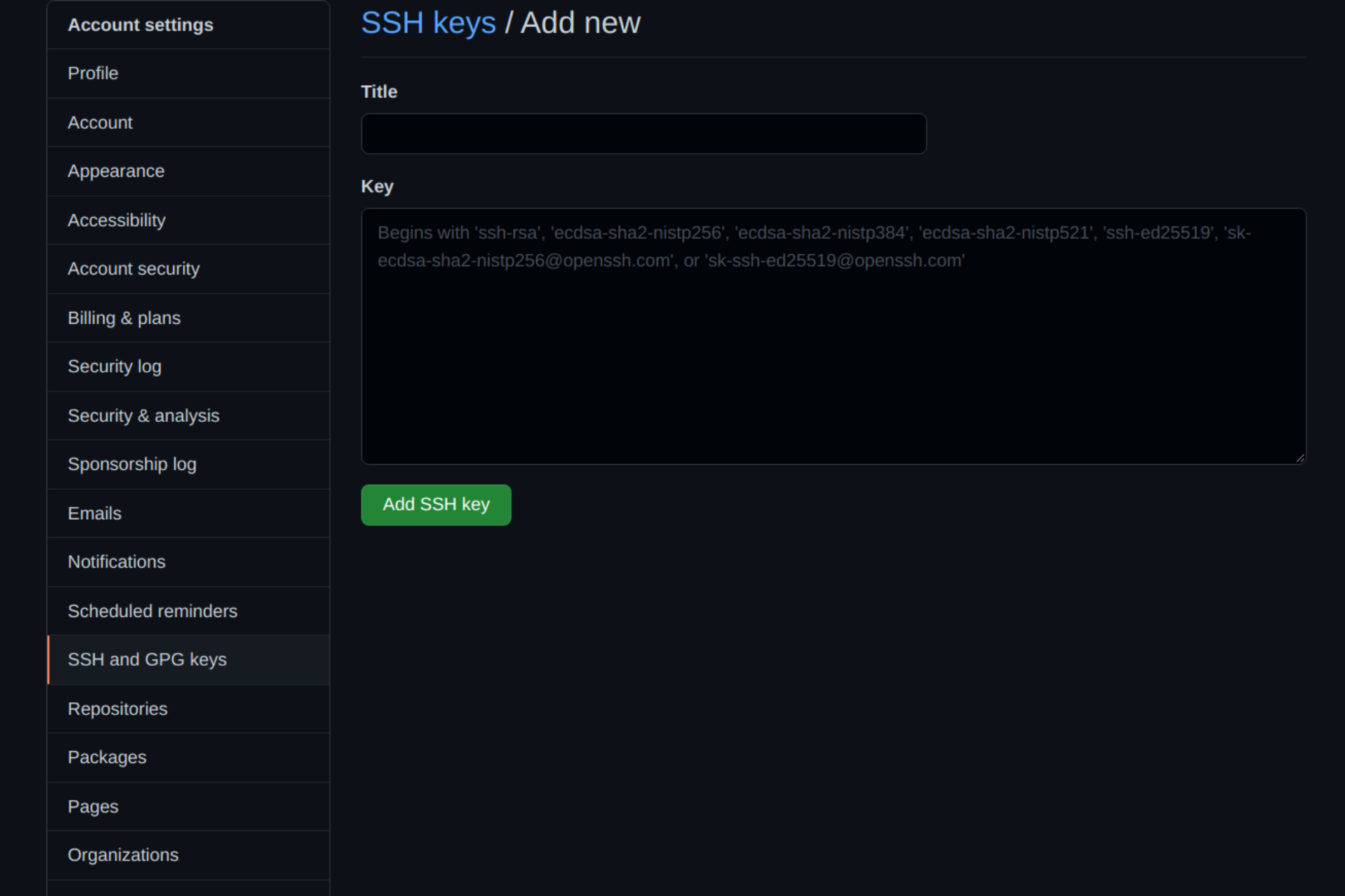
The key is now visible in the list of SSH keys linked to your account:

GitLab
Sign in to your GitLab account using a browser by going to gitlab.com and entering your username and password. Click your profile photo in the upper-right corner of the page, then Settings:
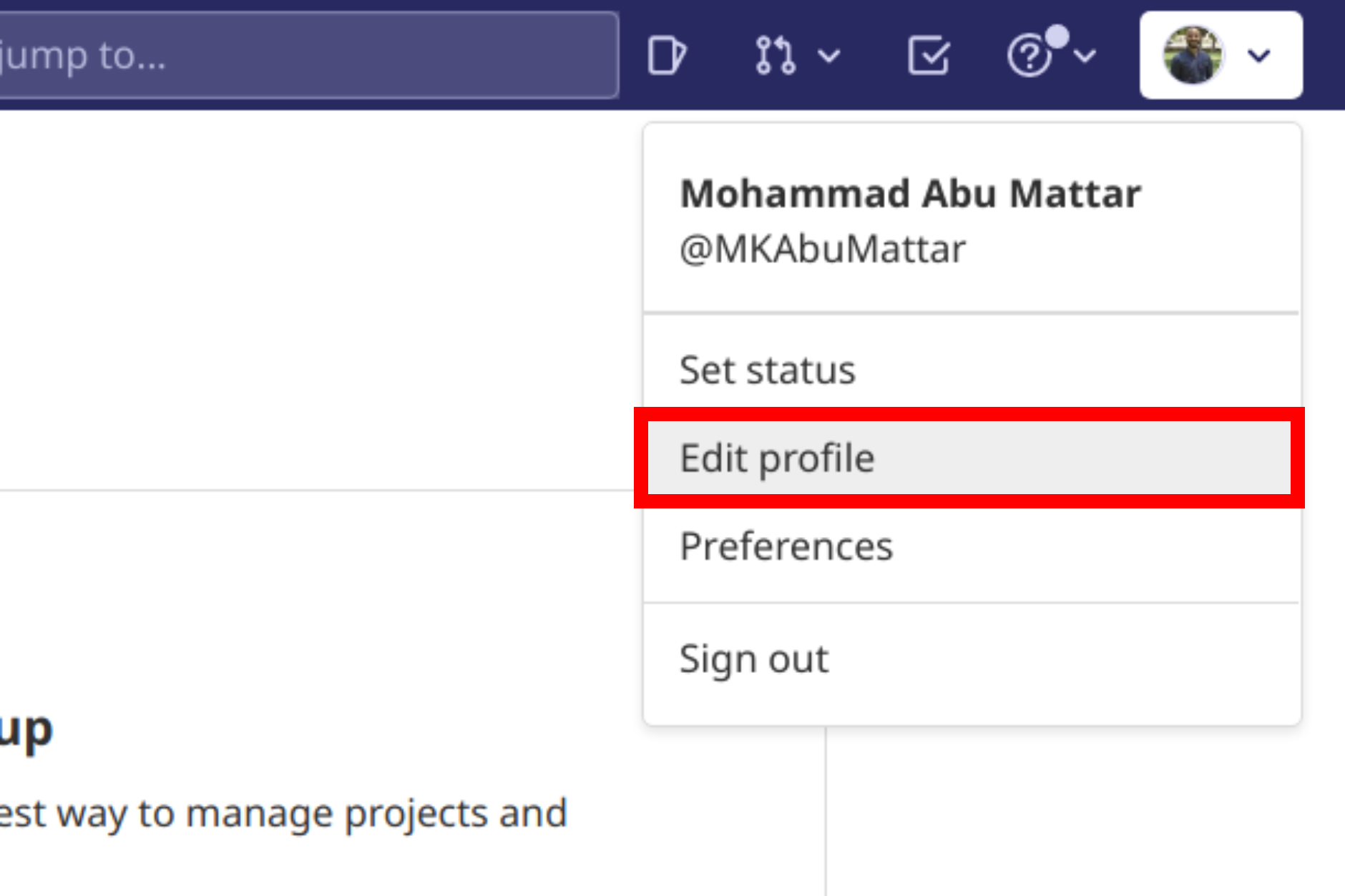
Click SSH Keys in the User Settings sidebar. In the Key area, paste your public key. Fill in the Title area for the new key with a descriptive term (for example, the name of your computer). Finally, click the Add key:
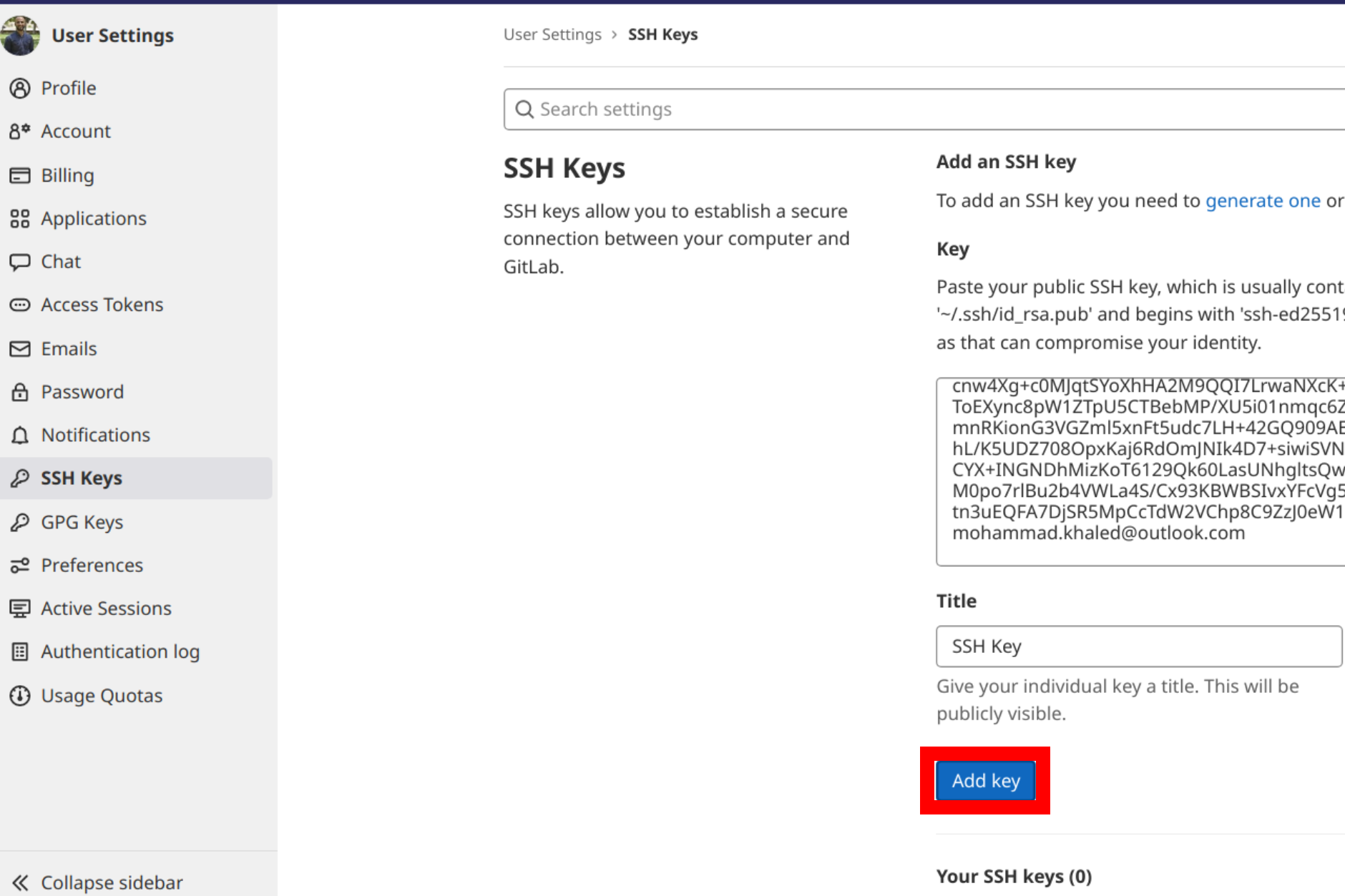
The key is now visible in the list of SSH keys linked to your account:

Bitbucket
Log in to your Bitbucket account using a browser by going to bitbucket.org and entering your username and password. Click your profile photo in the lower-left corner of the website, then Bitbucket settings:
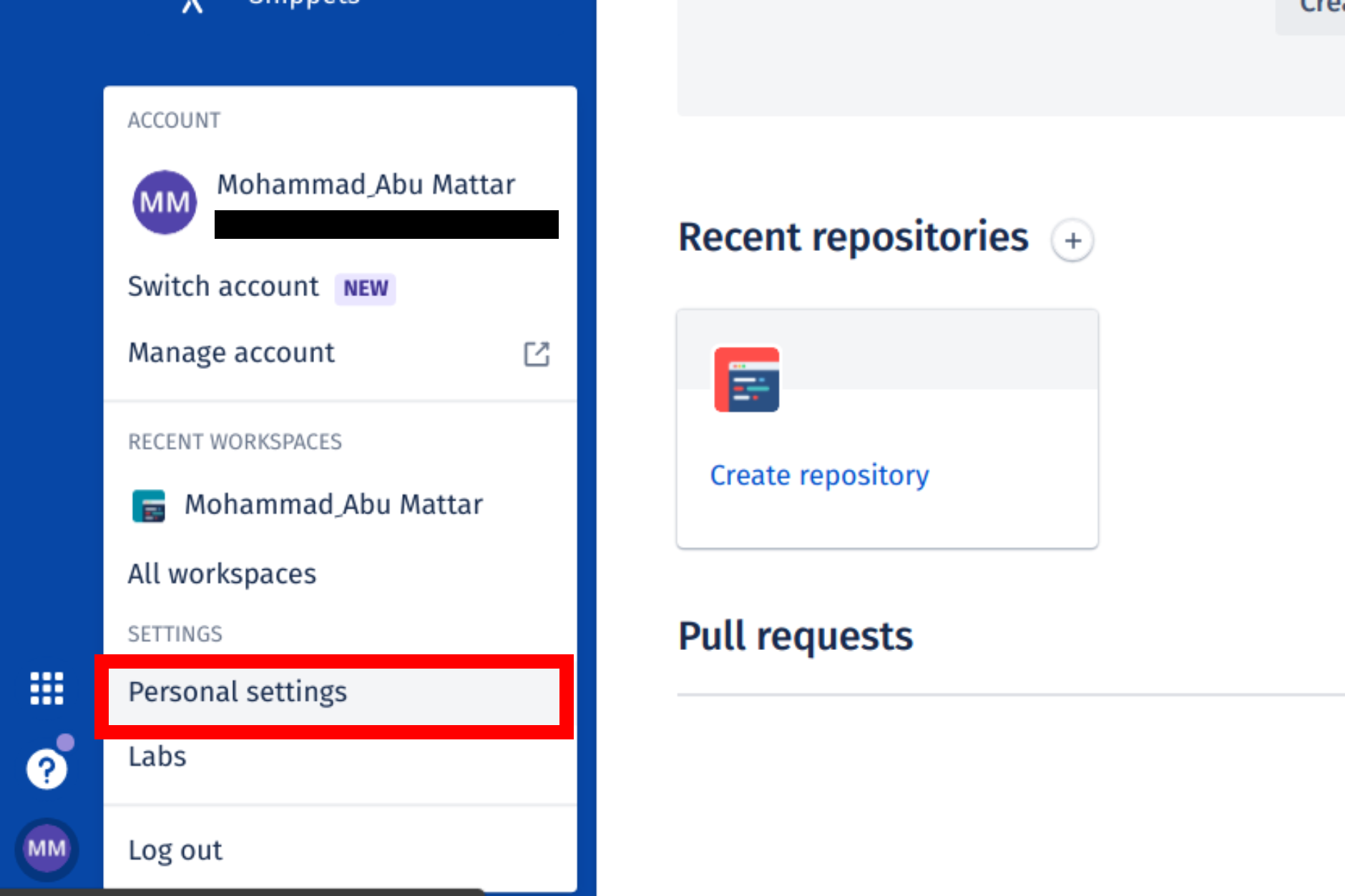
SSH keys may be found in the Settings sidebar’s Security section. After that, select Add key from the drop-down menu. Fill up the Description box with a descriptive label for the new key (such as your computer’s name), and then paste your public key into the Key field. Last but not least, choose to Add key:
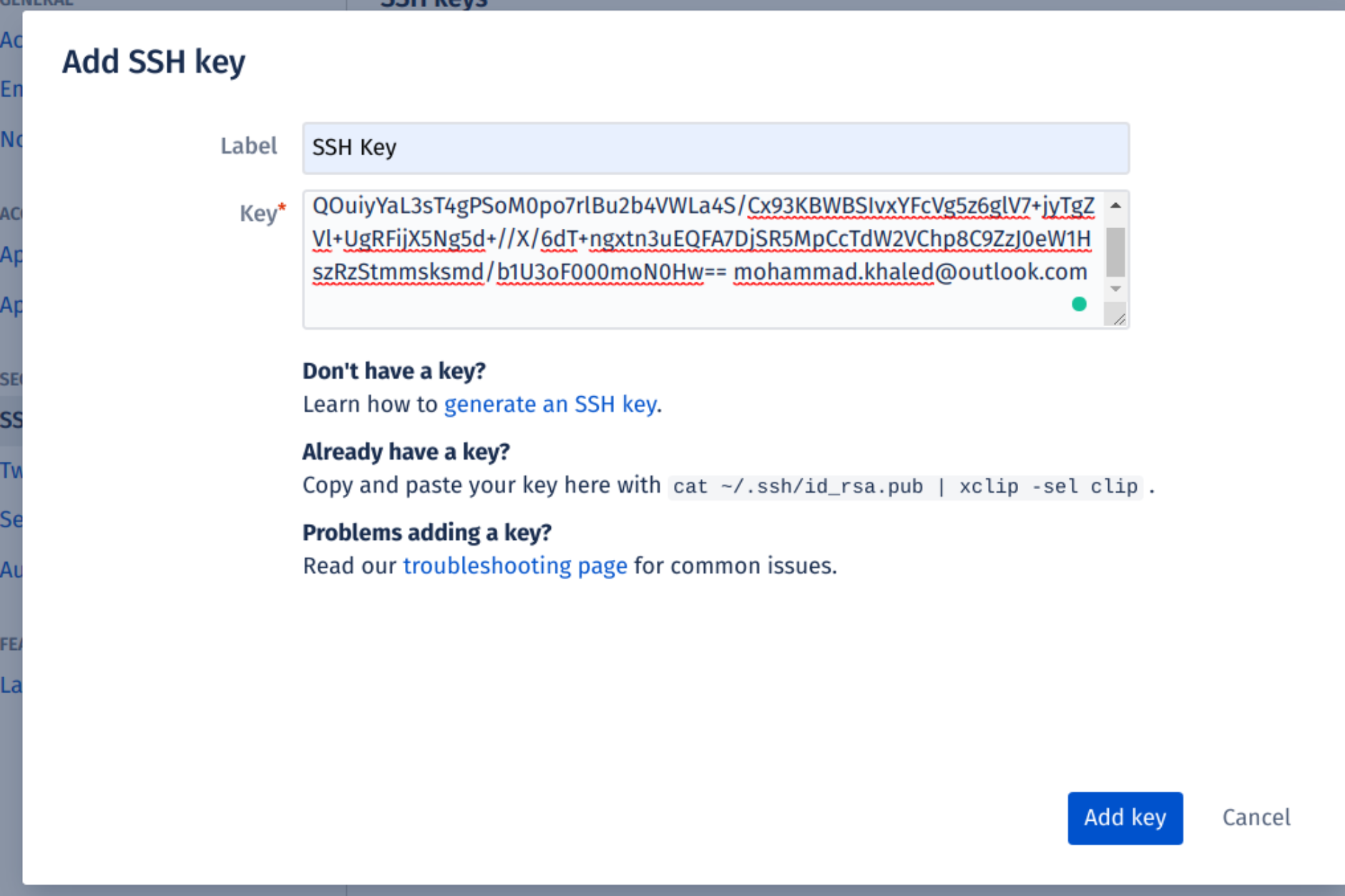
The key has now been added to your account’s list of SSH keys:
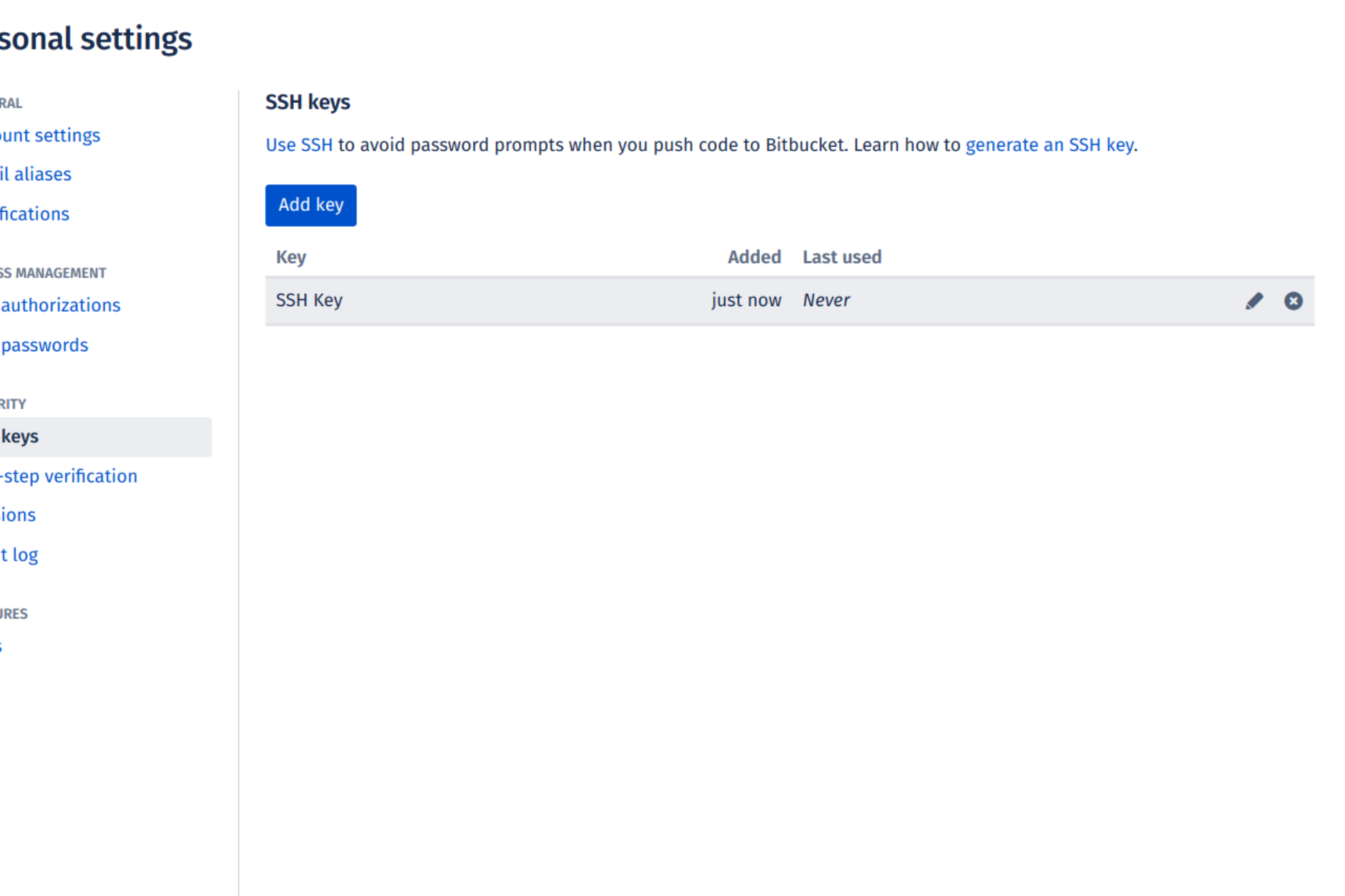
Test connecting via SSH
Before utilizing SSH with Git, GitHub, GitLab, and Bitbucket allow you to verify whether the connection has been set up successfully.
GitHub Test Connecting via SSH
Open the terminal once you’ve added your SSH key to your GitHub account and type:
ssh -T git@github.comIf you’re connecting to GitHub over SSH for the first time, the SSH client will ask if you trust the GitHub server’s public key:
The authenticity of host 'github.com (140.82.113.4)' can't be established.RSA key fingerprint is SHA256:a5d6c20b1790b4c144b9d26c9b201bbee3797aa010f2701c09c1b3a6262d2c02.Are you sure you want to continue connecting (yes/no)?Press Enter after typing yes. GitHub has been added to the list of trustworthy hosts in the SSH client:
Warning: Permanently added 'github.com,140.82.113.4' (RSA) to the list of known hosts.You won’t be asked about GitHub’s public key again once you’ve added it to the list of known hosts.
The server notifies you that you have successfully authenticated and ends the connection: Because this remote access through SSH is offered by GitHub only for testing purposes and not for practical usage, the server informs you that you have successfully authenticated and terminates the connection:
Hi YOUR_USER_NAME! You've successfully authenticated, but GitHub does not provide shell access.If you passed the test, you may now utilize SSH with GitHub.
The entire interaction should look something like this:
ssh -T git@github.com
The authenticity of host 'github.com (140.82.113.4)' can't be established.RSA key fingerprint is SHA256:a5d6c20b1790b4c144b9d26c9b201bbee3797aa010f2701c09c1b3a6262d2c02.Are you sure you want to continue connecting (yes/no)? yesWarning: Permanently added 'github.com,140.82.113.4' (RSA) to the list of known hosts.Hi your_user_name! You've successfully authenticated, but GitHub does not provide shell access.YOUR_USER_NAME@YOUR_HOST_NAME:~>GitLab Test Connecting via SSH
The test is pretty similar if you’ve added your SSH key to your GitLab account:
ssh -T git@gitlab.com
The authenticity of host 'gitlab.com (35.231.145.151)' can't be established.ECDSA key fingerprint is SHA256:4ac7a7fd4296d5e6267c9188346375ff78f6097a802e83c0feaf25277c9e70cc.Are you sure you want to continue connecting (yes/no)? yesWarning: Permanently added 'gitlab.com,35.231.145.151' (ECDSA) to the list of known hosts.Welcome to GitLab, @YOUR_USER_NAME!If you passed the test, you may now utilize SSH with GitLab.
Bitbucket Test Connecting via SSH
The test is pretty similar if you’ve added your SSH key to your Bitbucket account:
ssh -T git@bitbucket.org
The authenticity of host 'bitbucket.org (104.192.143.1)' can't be established.RSA key fingerprint is SHA256:fb7d37d5497c43f73325e0a98638cac8dda3b01a8c31f4ee11e2e953c19e0252.Are you sure you want to continue connecting (yes/no)? yesWarning: Permanently added 'bitbucket.org,104.192.143.1' (RSA) to the list of known hosts.logged in as YOUR_USER_NAME.
You can use git or hg to connect to Bitbucket. Shell access is disabled.If you passed the test, you may now utilize SSH with Bitbucket.
References
- GitHub Docs: Generating a new SSH key and adding it to the ssh-agent
- GitHub Docs: Adding a new SSH key to your GitHub account
- GitLab Docs: Use SSH keys to communicate with GitLab
- Bitbucket Docs: Set up an SSH key
- OpenSSH Official Website
ssh-keygenman pagessh-agentman pagessh-addman page- ArchWiki: SSH keys
- DigitalOcean: How To Set Up SSH Keys
- Git SCM Book: Git on the Server - Generating Your SSH Public Key
- xclip man page (or alternative like xsel)
- SSH (Secure Shell) Protocol Overview




